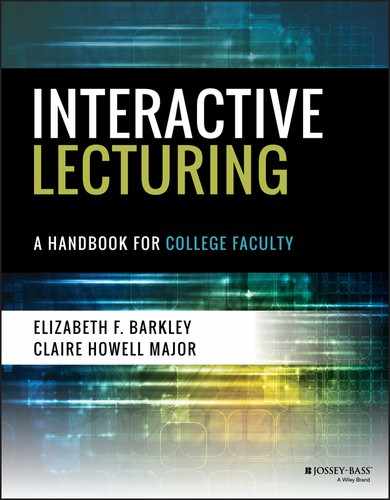ENGAGING LECTURE TIP 45
Voice Modulation
There is an unfortunate but common image of the lecturing professor droning on and on in a dull, monotone voice. However, professors need not be monotone; rather, they can raise or lower their voices, increase or decrease their rates of speech, and stress particular words and phrases to make their lectures more engaging. In this Tip we recommend that professors practice voice modulation to engage and inspire students. Modulating your voice enables you to draw students in, help them stay alert, and refocus their attention.
You may modulate your voice in several key ways.
Volume Volume is how loud your voice sounds to students. Gauge what the volume of your voice should be in your classroom when it is full. You can do this by practicing while it is empty and then adjusting as needed when it is full; you can simply ask students at the back of the class if they can hear you to be sure. If your voice is too soft, students will not be able to hear you or will stop listening to you. If you are too loud, they may think you are shouting and tune you out. Moreover, after finding the normal volume, you can draw attention to your lecture by varying it. Speaking softly can be used as an attention getter, and speaking loudly can also help you illustrate key points.
Pitch Pitch refers to how high or low your voice is. Generally you will want to lower your voice to the lowest level in your comfort range. Lower voices tend to be easier to understand, whereas higher-pitched voices can sound shrill and be aggravating, particularly over a microphone. However, lecturers can also intentionally vary the pitch of their voices. Lowering the voice pitch on a select word or phrase gives it authority and emphasis. Going up in pitch can add interest to a sentence and encourages engagement.
Rate Rate is the speed in which you speak. A typical conversational speech rate is about 120 words per minute, but formal speeches tend to be a bit faster paced, ranging from 150 to 160 words per minute (Dlugan, 2012). That said, one of the biggest mistakes lecturers can make is to speak too quickly. Slowing down helps get your point across to students. However, speeding up occasionally for emphasis can add excitement and energy.
Pauses Pauses are breaks in speaking. They signal to listeners that you are moving on to a new idea. They can also add expression to a lecture. They are best used deliberately in order to achieve a desired effect. For example, you can pause to introduce a new idea to give students time to absorb what you are saying. Or you can pause to display a slide or other visual aid, which provides students time to process the visual without missing your next thought. You can also use pauses, however, simply to catch your breath. When you do pause, however, avoid vocalized pauses such as ummm or ah or er because these can be distracting and annoying and ultimately detract from your message.
Example
Key References and Resources
- Dlugan, A. (2012). What is the average speaking rate? Retrieved from http://sixminutes.dlugan.com/speaking-rate/
- University of Pittsburg. (2008b). Verbal delivery tips. Retrieved from www.speaking.pitt.edu/student/public-speaking/suggestions-verbal.html
